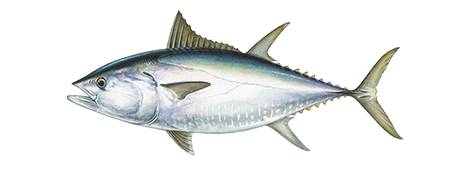Bluefin Tuna

The bluefin tuna is the largest tuna and one of the largest true bony fish.
HOW TO IDENTIFY A BLUEFIN TUNA
It can be distinguished from almost all others by its rather short pectoral fins which extend only as far back as the eleventh of twelfth spine in the first dorsal fin. There are 12-14 spines in the first dorsal fin and 13-15 rays in the second. The anal fin has 11-15 rays. It has the highest gill raker count of any species of Thunnus with 34-43 on the first arch. The ventral surface of the liver is striated and the middle lobe is usually the largest. The anal fin and the finlets are dusky yellow edged with black. The lateral keel is black in adults.
WHERE TO CATCH BLUEFIN TUNA
The bluefin tuna occurs in subtropical and temperate waters of the North Atlantic Ocean and in the Mediterranean and Black Seas. It is a pelagic, schooling, highly migratory species and like many species of fish, the smallest specimens form the largest schools and vice versa. The migration of the bluefin tuna appears to be the most extensive of all fish species and is tied to water temperature, spawning habits, and the seasonal movements of fishes on which the bluefin feeds. The giants of the species make the longest migrations, sometimes traveling across the entire span of the northern Atlantic Ocean. The following list includes additional details on where to catch this fish:
Baitfish Patches Coastal Waters
Night Fishing The Open Ocean
HOW TO CATCH BLUEFIN TUNA
The diet of the bluefin tuna consists of squid, eels and crustaceans as well as pelagic schooling fish such as mackerel, flying fish, herring, whiting, and mullet.Fishing methods include drift fishing or trolling with live or dead baits such as mackerel, herring, mullet, or squid; and trolling with artificial lures including spoons, plugs, or feathers. Bluefin tuna are supreme in their size, strength and speed, and are a very important game fish. They are also extremely important commercially in many parts of the world and are managed under a strict set of federal guidelines. Any anglers wanting to target bluefin tuna must first make sure they are in compliance with all state and federal rules. The following are fishing methods used to catch this fish:
Drift Fishing Saltwater Trolling
Saltwater Jigging
The following are lures, tackle or bait that can be used to catch this fish:
Cut Bait Jigs
Saltwater Live Bait Squid
Trolling Lures